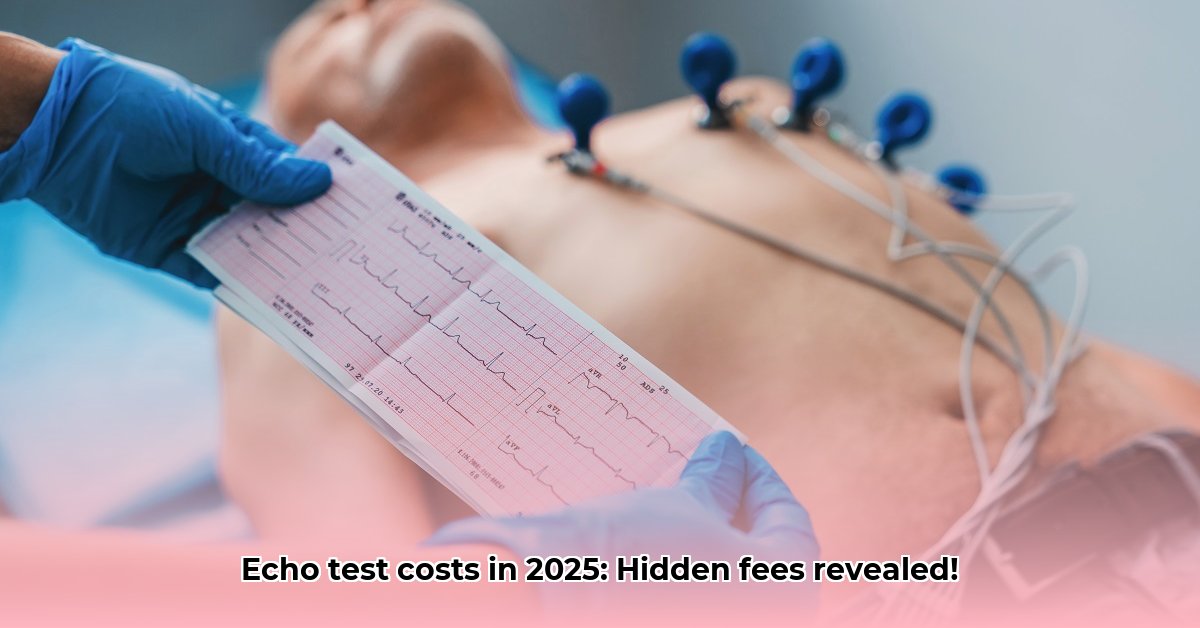Getting a medical test can be stressful, especially when you’re worried about the cost. An echocardiogram, or “echo,” is a common heart test, but figuring out how much it will cost can be tricky. This guide will help you understand what influences the price of an echo, how your insurance might cover it, and what you can do to keep costs down. We’ll break down everything you need to know so you can focus on your health, not your wallet. For more information on Medicaid coverage, see Medicaid coverage details.
Echo Test Charges: Understanding Your Heart Ultrasound Costs
Getting an echocardiogram, or echo test – a procedure using sound waves to create images of your heart – is a common procedure to check your heart’s health. Let’s untangle it together and make it easier to understand the cost of echocardiography.
What Affects the Price of My Echo Test?
The cost of an echocardiogram varies, depending on a few key things:
-
Your Insurance: This is the biggest factor. If you have insurance, you’ll likely pay a copay, deductible, and coinsurance. The specifics depend on your insurance plan, whether your doctor is “in-network,” and what your plan covers. Some plans might need you to get pre-authorization before the test. For Medicare and Medicaid, your coverage is based on your plan’s details and your eligibility. Expect to pay somewhere between $100 and $800 with insurance, but this is a broad estimate. It could be lower or higher.
-
The Type of Echo Test: There are different kinds of echocardiograms. A standard transthoracic echocardiogram (TTE) – where the ultrasound is done through your chest – is usually less expensive than a transesophageal echocardiogram (TEE), which involves a small probe going down your esophagus for a clearer view. A stress echocardiogram, combining exercise with the ultrasound, is generally the most expensive. A Doppler echocardiogram, which assesses blood flow, may add to the cost as well.
-
Where You Live and the Facility: Costs can change based on your location. Cities often have higher prices than smaller towns or rural areas. Hospitals usually charge more than smaller clinics or imaging centers. There’s often a separate charge for the cardiologist who interprets the results.
-
Facility Type: Hospitals generally have higher overhead costs compared to outpatient clinics or independent imaging centers, and these costs are often reflected in their charges for procedures like echocardiograms.
-
Technological Equipment: Facilities equipped with advanced imaging technology may charge higher fees to offset the costs of maintaining and operating this specialized equipment.
Let’s look at some cost specifics. Keep in mind these are estimates, and your actual costs might be different.
| Type of Echocardiogram | Estimated Cost (Uninsured) | Estimated Cost (Insured) |
|---|---|---|
| Transthoracic Echocardiogram (TTE) | $500 – $3,000 | $100 – $500 (with copay and coinsurance) |
| Transesophageal Echocardiogram (TEE) | $700 – $4,000 | $200 – $800 (with copay and coinsurance) |
| Stress Echocardiogram | $600 – $4,000 | $300 – $1000 (with copay and coinsurance) |
| Doppler Echocardiogram | $200 – $500 (additional) | Varies based on primary echo type and plan |
Important Note: These are broad ranges. Your actual cost depends heavily on your location, insurance (or lack thereof), and the specific facility you visit. It’s always best to get a cost estimate beforehand.
Taking Control: How You Can Manage the Costs
Here are some practical steps you can take to be a savvy healthcare consumer:
- Check Your Insurance Coverage First: Before scheduling your appointment, contact your insurance company. Find out what your copay, deductible, and coinsurance are for an echocardiogram. Ask if pre-authorization is needed, and how to obtain it.
- Shop Around (If You’re Uninsured): If you don’t have insurance, call several different facilities – hospitals, clinics, and imaging centers – to compare prices. Ask for an estimate up front before making an appointment.
- Negotiate or Ask About Payment Plans: Don’t be afraid to ask if they offer discounts for cash payments or payment plans to make it more manageable. Many facilities are willing to work with patients.
- Choose In-Network Providers (If Insured): Using doctors and facilities within your insurance network usually keeps your out-of-pocket expenses lower. Check your insurance provider’s website or call them to confirm.
- Ask Questions: Don’t hesitate to ask your doctor’s office or the billing department for a detailed breakdown of charges. Understand what everything on the bill is for.
Understanding Health Insurance
Health insurance plans typically cover a portion of the cost of healthcare services, including diagnostic tests like echocardiograms. However, the extent of coverage can differ based on the specific details of your insurance plan:
- Premium: The amount you pay each month to maintain your health insurance coverage.
- Deductible: The amount you must pay out-of-pocket before your insurance coverage begins to pay.
- Copayment (Copay): A fixed amount you pay for a specific healthcare service.
- Coinsurance: A percentage of the total cost of a healthcare service that you are responsible for paying.
- In-Network vs. Out-of-Network Providers: In-network providers have negotiated rates with your insurance company, resulting in lower costs.
- Pre-authorization: Some plans require pre-authorization for certain procedures.
Beyond the Immediate Costs: Long-Term Healthcare Strategies
Thinking ahead about your healthcare costs can save you money and stress in the long run:
- Preventive Care is Key: Regular checkups and a healthy lifestyle can sometimes prevent serious health problems, which may then lessen the need for expensive treatments or diagnostic tests, like an echocardiogram.
- Health Insurance Matters: If you don’t have health insurance, explore affordable options. Check if you qualify for subsidized plans or financial assistance programs in your area. It’s a worthwhile investment in your overall wellbeing.
Ultimately, understanding the costs involved in getting an echocardiogram is a crucial first step to managing your healthcare expenses. Take an active role, ask questions, and remember to talk to your doctor or healthcare provider about possible payment options. They’re there to help you through the process.
Decoding Your Echocardiogram Bill
The first step is understanding what influences the cost. Think of it like buying a car – the price varies based on the model (type of echocardiogram) and where you buy it (provider). A Transthoracic Echocardiogram (TTE), the most common type, is generally cheaper than a Transesophageal Echocardiogram (TEE). Location matters too: in-network providers will typically cost less than out-of-network ones.
How to Negotiate Lower Echocardiogram Costs with Insurance and Providers
Negotiating medical bills may seem daunting, but it’s often possible and worth exploring.
Steps for Negotiating:
- Get Multiple Quotes: Call several providers and ask for price estimates. Note the differences.
- Negotiate a Cash Price: For those with high deductibles, negotiating a discounted cash price can save money. Be polite but firm.
- Payment Plans: Many providers offer payment plans, making large bills more manageable. Inquire about options.
- Check for Errors: Carefully examine the final bill for any errors or overcharges. Challenge anything you think is incorrect.
- Financial Assistance: Ask providers or local charities about financial assistance programs.
Protecting Yourself Financially
Remember these tips:
- In-Network Providers: Always prioritize in-network providers for lower costs.
- Pre-Authorization: Always get pre-authorization from your insurer.
- Detailed Bill Review: Scrutinize your bills meticulously.
| Type of Echocardiogram | Estimated Cost Range (with Insurance) | Estimated Cost Range (without Insurance) |
|---|---|---|
| TTE (Transthoracic) | $150 – $1,000 | $500 – $3,000+ |
| TEE (Transesophageal) | $300 – $2,000 | $700 – $4,000+ |
| Stress Echocardiogram | $400 – $2,500 | $600 – $4,000+ |
| Doppler Echocardiogram | $50 – $500 (additional) | $200 – $500 (additional) |
Disclaimer: The cost ranges above are estimates, and actual costs can vary considerably based on geographic location, provider, and specific insurance plans. This information is not a substitute for professional medical advice. Always consult with your healthcare provider and insurer for accurate information.
- Your Perfect Bento Box Bag For Fresh And Tidy Meals - December 2, 2025
- Korean Meal Prep Made Easy For Delicious Weekday Meals - December 1, 2025
- Korean Food Meal Prep Makes Flavorful Weekday Meals Simple - November 30, 2025










